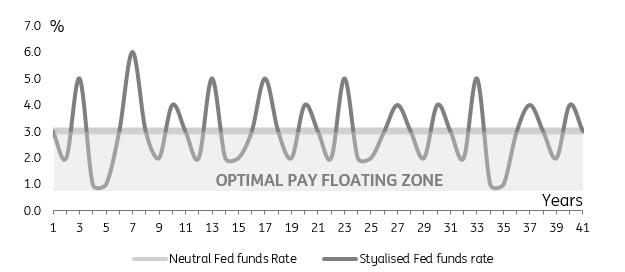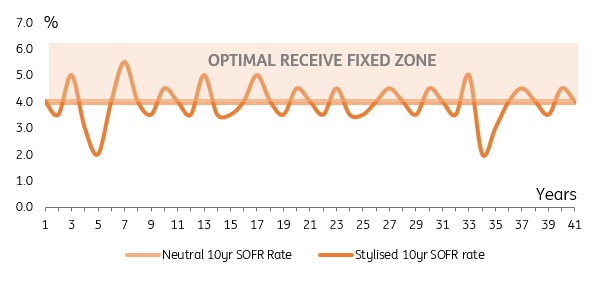US Rates Heading Deeper Into The Zone Of Interest

Image Source: Pexels
Don't get us wrong – we're not going all bullish on Treasuries. But for swap players looking for opportunity, it would be remiss of us not to note that long tenor SOFR rates are now trading at above what we would call neutral valuations. Not only are they set to get tastier still, but we are on the cusp of hitting impact positive carry circumstances, which make swaps to floating that bit more palatable to set.
So far in the current rate cut cycle the Federal Reserve has cut the funds rate by 100bp. Over the same period, the 10yr rate has risen by c.100bp. That 200bp swing is remarkable. The best explanation for this is reflected in changes in the market rate cut discount. When the Fed first cut in September 2024, the end-2025 funds rate was discounted at 2.8%. Now it’s 3.9%, up 110bp; broadly equivalent to the move in the 10yr rate.
So why have longer tenor rates shown an inverse relationship to the Fed funds rates, where are we going to next, and crucially, what should we be doing about it?
First, why the inverse relationship? This is largely a function of the re-set higher of the expected terminal funds rate, in turn driven by sticky inflation (albeit now at better levels), elevated bond supply pressures, ongoing underlying “macro-oomph” and a “risk-on” backdrop. Intertwined with this is a Trump-administration policy agenda that contains a pretty clear upside risk for prices through a tax-cutting and tariff-hiking combination.
Second, what about direction ahead? The impulses that drove longer tenor rates to where they are, have absolutely not gone away. But that does not mean they should continue to dominate forever. A limiting factor is the mean-inversion pull of straying too far from neutral valuations.
Stylised vision for the Fed funds rate over the long term
And the "Neutral" Fed funds rate

Source: Macrobond, ING estimates
In simplistic terms we view 4% for 10yr SOFR as representing neutrality (and the 10yr Treasury yield is currently pitched at 50bp above 10yr SOFR). See here for why. The same outcome can be theorised by hypothesising that the funds rate will tend to move between 2% and 5% through most cycles, maybe 1% to 7% under most extremes. The 10yr is longer looking, and will tend to average through the cycles, plus a premium for its lower volatility value.
The averaging central tendency for the funds rate through business cycles is thus in the area of 3%, and we can add a c.100bp “lower volatility” premium to that. That is based off the average spread between the funds rate and the 10yr risk free rate since 1990 (on Libor it was 150bp, and we've calmed this to 100bp for SOFR). It delivers the aforementioned neutral valuation of c.4%, obviously with some degree of fuzziness around it.
Stylised vision for the 10yr SOFR rate over the long term
And the "Neutral" 10yr SOFR rate.

Source: Macrobond, ING estimates
If we accept c.4% (give or take 25bp) as a neutral level for 10yr SOFR, we can then ask where can the 10yr rate get to; relative to neutrality. We think it should be above. Conservatively we'd assert that c.50bp over neutrality is not a dramatic ask in an environment where inflation is arguably running at c.50bp over where we’d like it to be. And it’s not just that. It’s the 7% fiscal deficit, and the Trump policy agenda (albeit not yet crystallised). That gives us 4.5% as a conservative target for 10yr SOFR (equating to 5% for the 10yr Treasury yield), and it could well be more. We continue to target the US 10yr Treasury yield at 5% to 5.5% during 2025.
What should we be looking to do as we enter this zone of opportunity
And finally, what should we be doing about this? For tactical players, we’re still fixed rate payers for choice, or short in duration for asset managers. That’s the straightforward outcome.
But there is another more structural strategy at play here, which is the notion of opportunity to set structural long positions (long duration / fixed rate receivers) in the course of the next number of weeks and months. Turning points are notoriously difficult to call. We usually see them in the rear-view mirror. Fading in such positions is a key play for those that believe we’re stretching too far from the neutral level.
Let’s make an obvious point.
When setting a fixed rate receiver, it’s ideal to do so when the fixed rate that is being received is elevated, and the more elevated the better.
Now, take the 10yr SOFR rate. Today it's at 4.2%. On our analysis that’s c.20bp above long run “neutral”. That’s good, as its better than average by 20bp. In addition, and as explained above, the likely floating leg should be some 100bp lower still (on average ahead).
In addition, one of the irritations on setting fixed rate receivers so far in this cycle is they come with negative carry up front. In other words, swapping to floating means volunteering to, for example, move from a lower 10yr SOFR rate to pay a higher floating SOFR rate. That can be a tough one to stomach. But that circumstance is practically at an end. Indeed, 20yr SOFR touched the 3mth SOFR rate this week. And if we are proven correct and the 10yr SOFR rate indeed treks towards 4.5%, we’ll move into an impact positive carry environment.
This can be a game changer, as the opportunity can be there to both reduce funding costs on impact, lock in at a rate that is sitting comfortable above average, and then benefit directly from any and every rate cut the Fed decides to deliver in 2025. Even if the Fed were to hike in subsequent years, the expectation would still be for the average funds rate to be below the 10yr SOFR rate set today (or in the coming weeks) in the next 10 years. Can we see better levels? Sure, and we continue to anticipate that. But we're in the zone where fading in ahead is a viable option to look at.
More By This Author:
Rates Spark: Unless The Print Is Sub-150k, No Change In ToneWeak Automotive Sector Drags Down Czech Industry
FX Daily: Sterling Exceptionalism Hits A Speed Bump
Disclaimer: This publication has been prepared by the Economic and Financial Analysis Division of ING Bank N.V. (“ING”) solely for information purposes without regard to any ...
more


